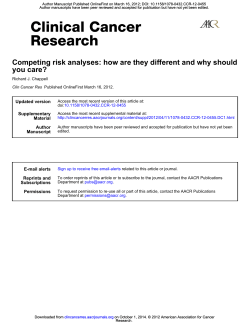
C u t t i n g E...
Cutting Edge ONCOLOGY Barbara E. Kitchell, DVM, PhD, Diplomate ACVIM (Oncology), & Hsin-Yu Ho, DVM, MS Michigan State University Peer Reviewed Rescue Therapy for Canine Lymphoma Chemotherapy failure is an obstacle veterinarians frequently encounter when treating non-Hodgkin’s lymphoma in dogs. A lthough more than 90% of canine patients achieve initial remission with standard cyclophosphamide, doxorubicin, vincristine, and prednisone (CHOP-based) treatment protocols,1-5 most eventually relapse and require rescue therapy, which is designed to re-induce remission in cases of relapsed lymphoma. Some relapsed dogs become refractory to additional chemotherapy protocols, with lymphoma persisting despite multiple treatment attempts. Cures are rare in patients with relapsed or refractory canine lymphoma. Because cancer cells become increasingly more resistant to chemotherapeutic agents during the course of therapy, they are more likely to express features of a multidrug resistance phenotype that can arise as a result of 6: ● Reduced intracellular drug concentration ● Decreased cellular uptake or increased drug excretion ● Up-regulation of inhibitors of apoptosis ● Intracellular or systemic drug detoxification ● Increased expression of cellular damage repair and stress response genes Lymph node measurement for stage and lymphoma evaluation Courtesy of Pamela D. Jones, DVM CONTINUES Cutting Edge / NAVC Clinician’s Brief / September 2011 ......................................................................................................................................................................61 Cutting Edge CONTINUED Inadequate dosing, wrong frequency, and incorrect route of administration can lead to drug resistance. Pharmacokinetic or systemic reasons for drug resistance include inadequate dosing, wrong frequency, or incorrect route of administration. Relapses may also occur because cytotoxic drug concentrations are not achieved at specific anatomic sites, such as the central nervous system.7 Many drug protocols have been adapted for canine lymphoma in the past 3 decades. Different protocols have varied response rates, durations of remission, and major toxicity events. There is no consensus on optimal rescue therapy. Reported single-agent and multidrug rescue protocols are summarized in Tables 1 and 2, respectively. Making Rescue Protocol Decisions A common dilemma faced by clinicians when addressing relapsed lymphoma patients is whether to repeat the original induction protocol or change to a rescue protocol containing novel agents. In theory, cells are less likely to be refractory to drugs with different mechanisms of action. In our practice, we may re-induce remission with original induction protocols in patients maintained in remission for 6 months or longer prior to relapse after completion of the induction protocol. Conversely, novel drugs or protocols are indicated if the patient has relapsed within 6 months or failed to achieve remission on the induction protocol. The observed probability of achieving complete or partial remission with a given rescue protocol varies in the literature but generally falls within the 28% to 77% range for a median duration of 40 to 129 days.8-16 However, the drugs used in the initial protocol may influence the success of relapse treatment. RESCUE THERAPIES Relapsed Lymphoma Novel rescue agents are indicated if the patient fails to achieve a durable remission in the induction phase. Single agents are generally not robust when used for rescue therapy because lymphoma cells are likely to exhibit greater drug resistance than during the induction protocol. The use of single agents increases the likelihood of short remission durations and the risk for up-regulation or drug resistance pathways. Multidrug protocols generally provide better durations of subsequent remission, as multidrug protocols are inherently associated with higher rates of log cellular cytotoxicity. However, singleagent therapy may provide a reasonable alternative for clients with financial or logistic restrictions. Many veterinary oncologists administer Lasparaginase at the time that relapse or refractory lymphoma is diagnosed. A previous study demonstrated that L-asparaginase does not prolong the overall duration of remission17 but can transiently decrease tumor burden by inhibition of protein synthesis.18 Use of L-asparaginase offers the owner time to consider available rescue therapy options; in addition, the patient may experience improved quality of life for a limited period. Second Relapse or Refractory Lymphoma Additional rescue therapy protocols may be initiated to re-induce third or even additional remissions when patients fail rescue therapy. Thorough re-staging for tumor volume should be performed before initiation of subsequent rounds of rescue therapy. Novel drug strategies become harder to design because effective chemotherapeutic drugs have been applied to previous protocols. CONTINUES 62 ......................................................................................................................................................................NAVC Clinician’s Brief / September 2011 / Cutting Edge Table 1. Single-Agent Chemotherapy Protocol Response Rate* (response/total) Median Duration of Remission in Days (range) Toxicoses (% cases) Reference Lomustine 28% (11/41) 86 (32–212) Thrombocytopenia & neutropenia† Moore et al 19998 Dacarbazine 35% (14/40) 43 (22–123) Thrombocytopenia (67%) Griessmayr et al 20099 Dactinomycin 41%‡ (20/49) 129‡ (42–1293) Neutropenia (26%) Bannink et al 2008*13 * Complete remission + partial remission † Percent (%) of total cases not provided ‡ Complete remission only Table 2. Multidrug Rescue Protocols Protocol Response Rate* (response/total) Median Duration of Remission in Days (range) Toxicoses (% cases) Reference MOPP 65% (76/117) 60 (21–763) GI (28%) Rassnick et al 200210 MPP 34% (14/41) 56 (34–238) Hematologic & GI† Northrup at al 200815 DMAC 72% (39/54) 61 (2–467+) Thrombocytopenia (56%) Alvarez at al 200611 Lomustine + DTIC 35% (20/57) 62 (34–90) Neutropenia (26%) Flory et al 200814 LCP 77% (37/48) 70 (2–940+) Hematologic† Saba et al 200916 A/temozolomide 72% (13/18) 40 (0–217)‡ Hematologic & GI† Dervisis et al 200712 A/DTIC 71% (25/35) 50 (0–587)‡ Hematologic & GI† Dervisis et al 200712 * Relapsed canine lymphoma only † Percent (%) of total cases not provided ‡ All patients were included; remission duration of 0 days means patients did not respond to the protocol A/DTIC = adriamycin (doxorubicin)/dacarbazine; A/temozolomide = adriamycin/temozolomide; DMAC = dexamethasone, melphalan, dactinomycin, cyclophosphamide; GI = gastrointestinal; LCP = L-asparaginase, cyclophosphamide, prednisone; MOPP = mechlorethamine, vincristine (Oncovin), procarbazine, prednisone; MPP = mechlorethamine, procarbazine, prednisone Cutting Edge / NAVC Clinician’s Brief / September 2011 ......................................................................................................................................................................63 Cutting Edge CONTINUED Subsequent remission periods for each additional rescue attempt have progressively shorter durations. Use of L-asparaginase offers the owner time to consider available rescue therapy options. Traditionally, radiation therapy has been reserved for ‘‘crisis’’ situations that require rapid reduction of localized tumor volume because of the exquisite sensitivity of lymphocytes to the cytotoxic effects of radiation.19 One study of radiation therapy for canine lymphoma reported a median survival time of 143 days following a 6-fraction protocol in which a total dose of 200 Gy was administered.20 Another study reported a partial response rate of 43% (3/7 dogs) for relapsed lymphoma in dogs treated with low-dose total body irradiation.21 In addition, single-node resection or radiation therapy for solitary resistant nodes has occasionally proved beneficial. BEYOND RESCUE THERAPY Salvage protocols could be offered at the time of minimal residual disease (MRD) if detection of subclinical malignant cells was feasible before clinical relapse; this could possibly lead to improved long-term survival. Some patients might benefit from treatment interruption, while others might require treatment intensification.22 In a recent study, thymidine kinase-1 levels measured during chemotherapy demonstrated very clear differences between dogs with lymphoma in complete remission and dogs with lymphoma out of remission.23 Molecular biological methods such as polymerase chain reaction (PCR) or reverse transcriptase PCR have been applied in veterinary oncology to detect MRD in peripheral blood or lymph nodes for staging purposes.24-27 Immunotherapy, including anti– human leukocyte antigen monoclonal antibody and telomerase targeting vaccination, has been described in limited clinical trials.28,29 Improvements in chemotherapy protocols, availability of new effective agents in veterinary oncology, and creation of robust preclinical biomarker assays will collectively improve future outcomes for dogs diagnosed with lymphoma. See Aids & Resources, back page, for references & suggested reading. MRD = minimal residual disease, PCR = polymerase chain reaction 64 ......................................................................................................................................................................NAVC Clinician’s Brief / September 2011 / Cutting Edge
© Copyright 2025





















